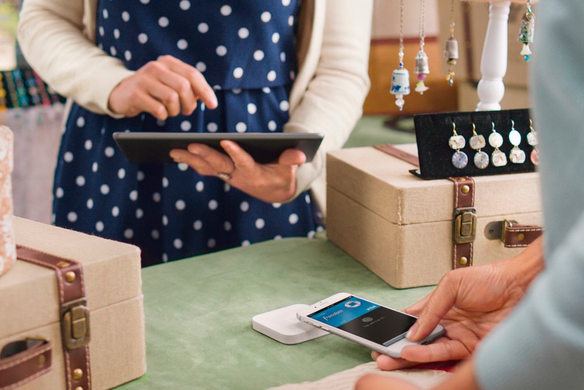Table of contents
Between texting, emailing, snapping photos, and posting on social media, it can feel like your smartphone is an extension of your hand. So it only makes sense that this increasingly indispensable device is evolving into a way to pay for things. Here’s a primer on mobile wallets, and why it makes sense for your business to accept this new form of payment.
How do mobile wallets work?
Mobile wallets use near field communication (NFC) to transmit information from your mobile device to a payments reader. In other words, it’s how you pay with your phone. NFC is a type of radio frequency identification (RFID) technology that allows your smartphone and a payments device to talk to each other wirelessly. That’s why, for obvious reasons, these types of transactions are also known as contactless payments.
What are some examples?
Apple Pay is perhaps the buzziest example of a mobile wallet so far. Here’s how it works: First, open Passbook on your iPhone 6 or 6 Plus, and add the credit or debit card you have associated with your iTunes account by entering the security code. When you’re ready to pay, just hold your finger on the Touch ID button to scan and verify your fingerprint. That will initiate the transaction. In addition to Apple, other major mobile wallet solutions are Samsung Pay and Android Pay.
What’s the benefit for small businesses?
Beyond the cool factor of paying with your phone, there are three key reasons why enabling mobile wallet payments is a smart move for business owners: security, speed, and convenience. NFC transactions are completed in seconds, which is faster than processing magnetic-stripe cards or making change. They’re also dramatically faster than EMV (chip card) payments, which can take longer than magstripe payments to complete. By accepting payments from mobile wallets, you can drastically reduce customer wait times at checkout.
Mobile wallets are also extremely convenient. They mean no more lugging around a wallet stuffed to the brim with credit cards. And if customers happen to have forgotten their wallet, they can still pay for things at your business with their phone.
But perhaps the biggest draw for consumers is knowing that transactions with their mobile wallets are extremely secure. In addition to the fingerprint verification that’s involved in contactless transactions like Apple Pay, the data associated with cards stored in mobile wallets is encrypted and constantly changing — which makes it near impossible for fraudsters to extract.
Right now it’s mostly large retailers that have the ability to accept payments from mobile wallets, but that’s changing fast. You can set yourself up to accept mobile payments like Apple Pay by purchasing an affordable NFC reader. Adopting NFC technology is an opportunity to set yourself apart with safe, streamlined payments.
More Resources:
Current Perspectives on the Mobile Wallet Evolution (Federal Reserve Bank of Boston)
Mobile Wallet Services Protection: What Consumers Should Know (Federal Trade Commission)
Migration to EMV Chip Card Technology and Your Small Business (Small Business Association)
![]()











